Dell XPS 13 Review
by Brett Howse on February 19, 2015 9:00 AM EST- Posted in
- Laptops
- Dell
- Ultrabook
- Broadwell-U
- XPS 13
Gaming Performance
Normally on an Ultrabook we would not dedicate an entire page to gaming performance, because the integrated GPUs do not perform very well on our gaming tests. However, with this being our first example of Broadwell-U, it is a good time to revisit this and see how the new graphics capabilities of Broadwell compare to the Haswell processors.
With the Core i5-5200U in both of the XPS 13s that we received, we have 24 execution units, compared to only 20 on Haswell-U. In addition, the 14nm process should help with throttling. The FHD model (1920x1080) arrived with a two 2GB memory modules and the QHD+ version came with 2 x 4GB.
First, let's look at the synthetic benchmarks, starting with 3DMark and then moving on to GFXBench.
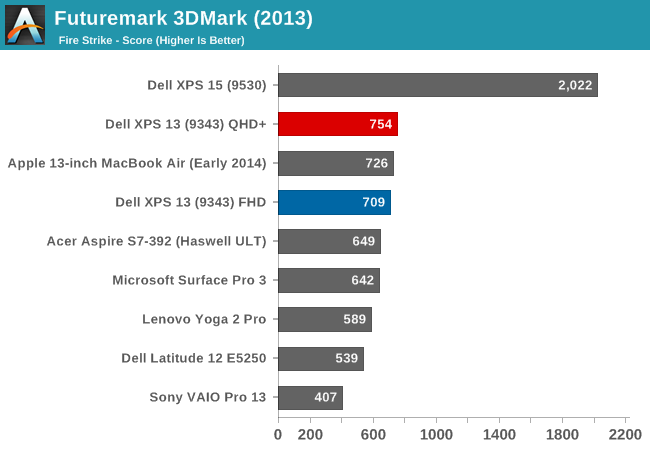
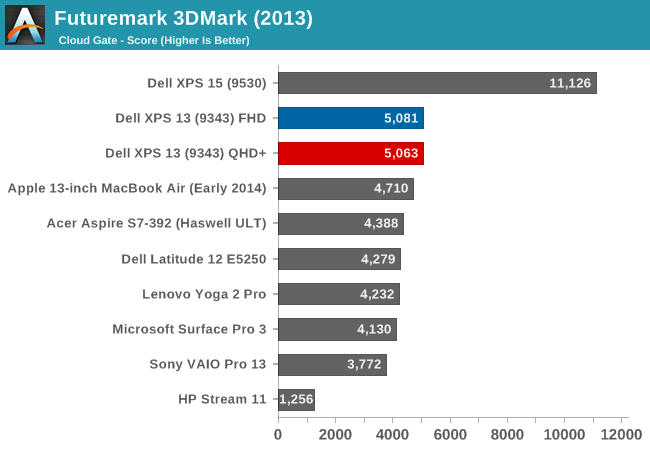
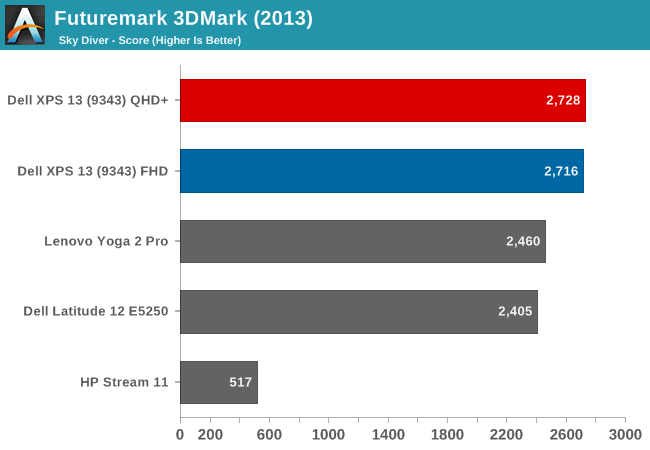

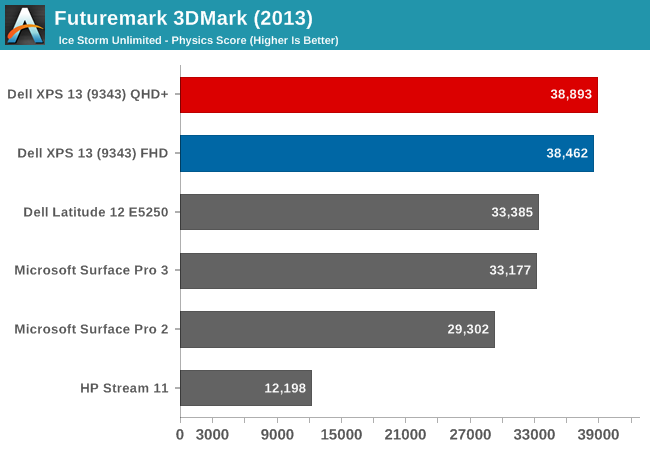
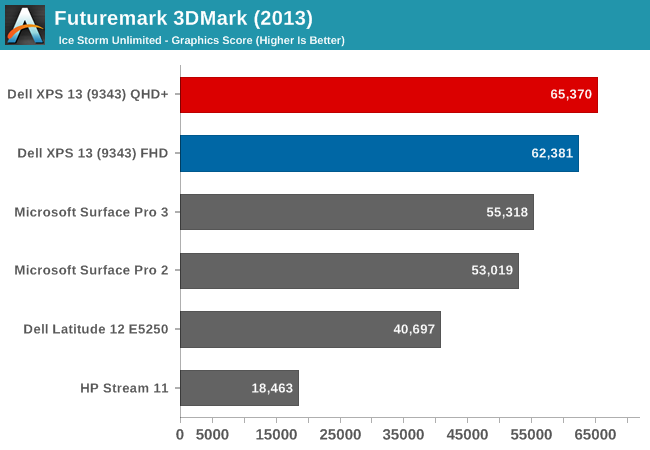
The 3DMark results begin to show the increased GPU performance of the Gen8 graphics. Broadwell-U outperforms all of the Haswell-U parts on all of the tests, and the QHD+ model gave a fraction more performance as well in a few tests.

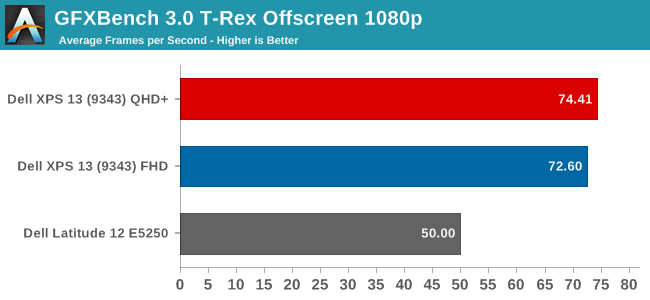

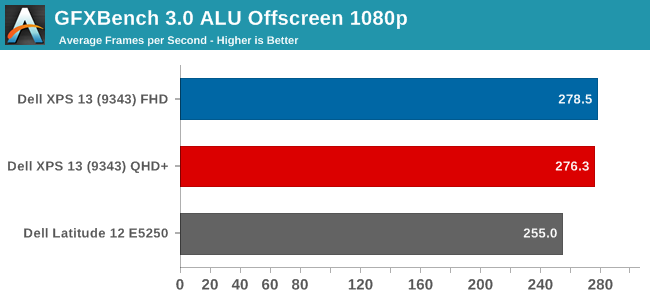
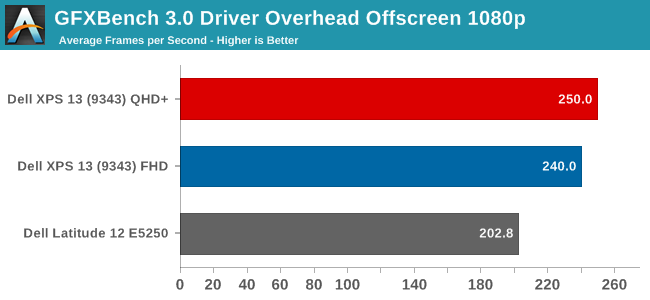
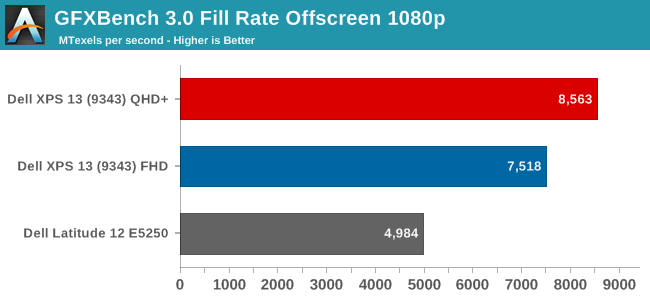
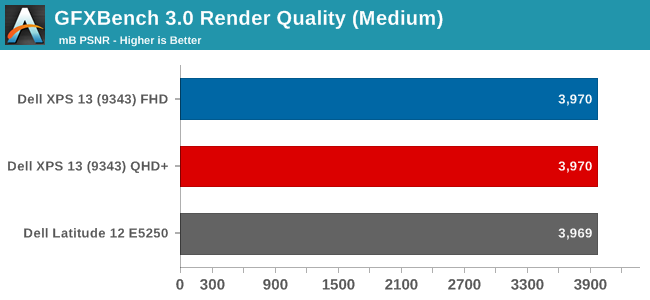
The initial results for the new GPU look pretty good, with the new GPU soundly beating the Haswell-U parts. The HP Stream 11, with just 4 EUs, trails quite far behind. GFXBench is one of our newer benchmark choices for Windows 8, and we will add more data as we get a few more devices to test.
Next, let's look at our gaming benchmarks. Due to the low performance of the integrated GPUs, I just ran our gaming tests at the Value (1366x768 ~Medium) settings.

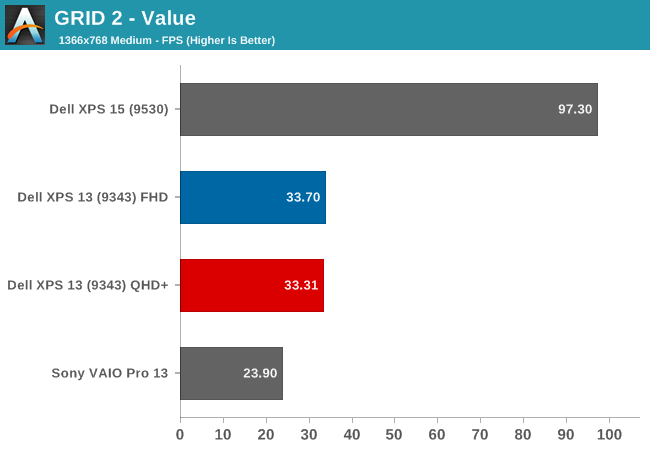

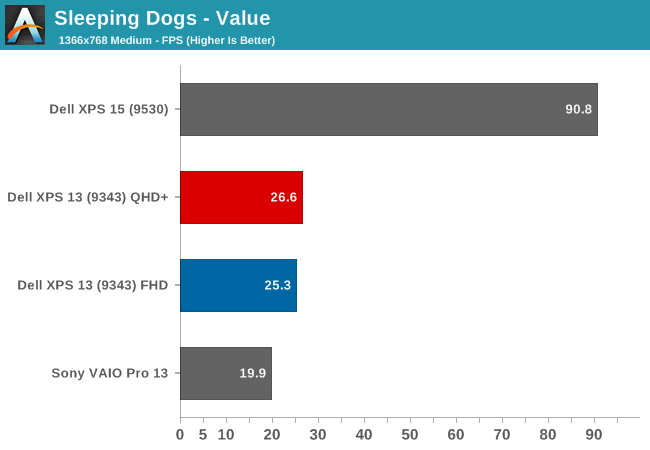
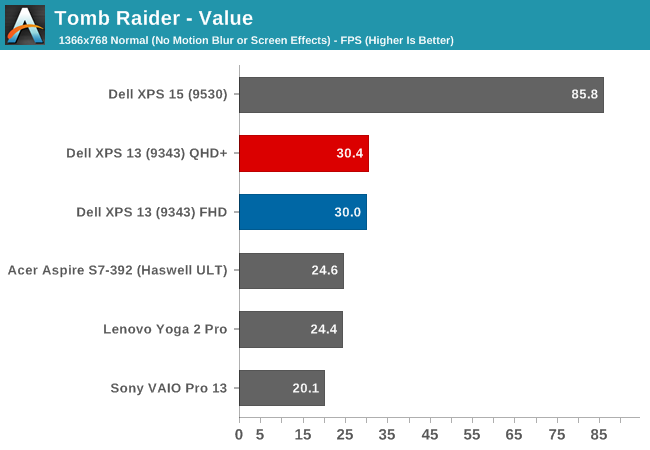
Here we can see once again that the new GPU is certainly stronger, but it is still not quite enough to make any of these games very playable on our Value settings. The Dell XPS 15, with its discrete GPU, carries a huge lead over the integrated GPU offerings. Still, the new Gen8 Graphics with more execution units per processor, as well as a change to the architecture of each execution unit, has made a healthy improvement. The new GPU has only eight EUs per sub-slice now, as compared to ten in Haswell-U, which help in many workloads. Ian has a nice writeup on the changes.
However, our gaming benchmarks are not tested at the lowest possible settings. All of the benchmarks start at 1366x768 with medium settings, so let's drop down another notch.
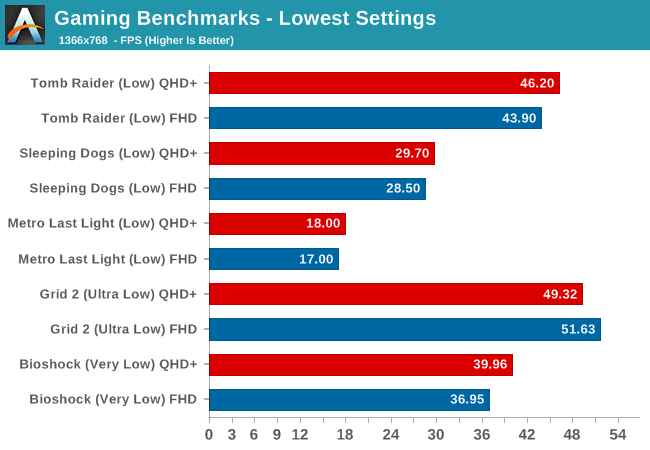
By setting the games to their lowest settings, some of them are now playable. We are still a long ways off of the performance of a discrete GPU, but slowly integrated graphics are improving.
Finally, we have a new gaming benchmark to add to our repertoire. Anand first used the DOTA 2 bench for the Surface Pro 3 review and it will be our go-to benchmark for devices like this without a discrete GPU. Our Value setting will be 1366x768 with all options off, low quality shadows, and medium textures. Midrange will be 1600x900 with all options enabled, medium shadows, and medium textures, and Enthusiast will be 1920x1080 with all options maxed out.
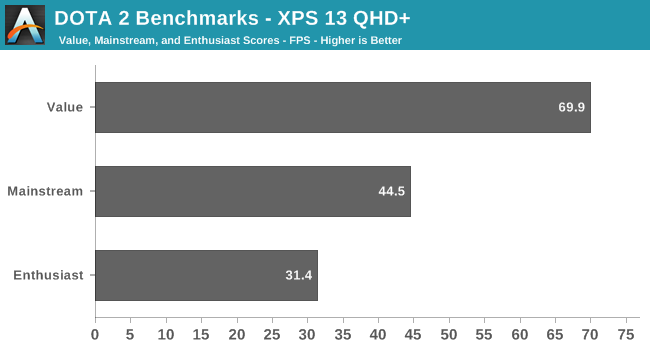
We do not have any other comparison points at the moment, but it is very clear that a game like DOTA 2 is very playable on a device with an integrated GPU. Frame rates, even with good settings, are very reasonable.
So Broadwell has raised the stakes again, but the end result is Intel's Integrated GPU is still not going to let you play AAA titles with good frame rates. Hopefully we can get some good comparisons between Broadwell-U and the AMD APUs in the near future. It will also be interesting to see what happens on the higher wattage Broadwell parts, some of which will contain significantly more EUs.










201 Comments
View All Comments
Brett Howse - Monday, March 23, 2015 - link
Someone else had asked me that, so I set the 3200x1800 display to 1600x900, just to see if part of the battery life loss was due to rendering. My battery life test for this setting was almost identical to the 3200x1800 resolution.So it does not improve battery life because the main power draw of the higher resolution display is the increased requirements of the backlight to drive the same brightness level through a much more dense TFT. At least that was my findings on the XPS 13.
growl - Monday, March 23, 2015 - link
Thanks very much, appreciate it! Torn on which one to buy, given that I am a frequent traveler, but also generally enjoy touch and have a pretty much unlimited budget.mazzy - Thursday, March 26, 2015 - link
Hi Brett, Any Update on Auto Dynamic LCD brightness ?Brett Howse - Saturday, March 28, 2015 - link
Nothing yet sorry.mazzy - Tuesday, April 7, 2015 - link
I think that it'll never be fixed. It's April.. over 3 months from the launch...It's a pity, a great quality screen but with a glaring defect... no calibration possible... :(
FranC - Wednesday, April 8, 2015 - link
I bought the 2015 Dell XPS 13 on the assumption that Dell would release a fix that would allow end users to calibrate the display. As mazzy said, it seems like Dell has no intention of fixing this, perhaps because it would reveal that battery life is highly dependent on Adaptive Brightness being enabled. Guess I'll wait to the last day to return it, and file this one away as being Duped-by-Dell.paul1508 - Monday, April 20, 2015 - link
Does the standard Dell Wireless 1560 support Intel Wireless Display (WiDi) or do I have to opt in the Intel AC 7260? Does that matter at all because the Dell Wireless 1560 might support Miracast?technoway - Monday, April 27, 2015 - link
The battery life for the system:i7-5500U / 8GB-RAM / 512GB-SSD / 3200x1800 infinity touch
is listed to be only about 7.5 hours.
The Apple 13-inch Macbook gets 10 hours or more.
But, Dell doesn't offer the 512 GB SSD, which I need for space, without also having the power-sucking HD+ screen. That stops me from buying the latest XPS-13.
Dell could make simple changes and make a machine I'd buy, but for some reason they don't do this.
The core i7 processor is a must, because it consumes less power than the core i5, and a 512 GB SSD is also a must to compete with Apple machines, but the HD+ screen wastes too much power. An HD screen is just fine on a 13-inch machine.
Until I can get a i7-5500U / 8GB-RAM / 512GB-SSD, with just the HD display (I don't care whether it's touch or not), I won't buy this. With the HD display, that system would have great battery life - I'd estimate at least 10 hours, and probably more like 11 or 12, maybe more. Dell ruins the machine by not offering the best options for battery life.
I do have an older first-generation XPS 13, and I like it, but with a meager 128 GB, 70 GB taken by the OS and restore partition, it's got too little storage.
If Dell makes the machine I want, I'll buy one tomorrow. If they don't make that by Christmas, I'll probably purchase the Apple 13 inch model. It has the good battery life for an Ultrabook.
Oh, and Dell's suggested solution for the poorer battery life is to carry around a plug-in battery pack for extra power. That competely defeats the purpose of having an Ultrabook!
vaga13ond - Saturday, June 11, 2016 - link
You're comparing apples to oranges there. Trying to compare the XPS vs a Macbook isn't really targeting the same user. Macbook's come with Core m3 or m5 (below i-series) processors not the i7 processor that you consider a "must." No touch screen, no QHD, worse on board graphics, DDR3, single port, yada yada yada... And no, the Macbook does NOT get 17.5+ hours on a battery charge doing anything besides idling. The XPS is a VERY different machine than the Apple Macbook...rgin - Monday, October 12, 2015 - link
Would the performance of this beauty be affected if we ran linux on it?